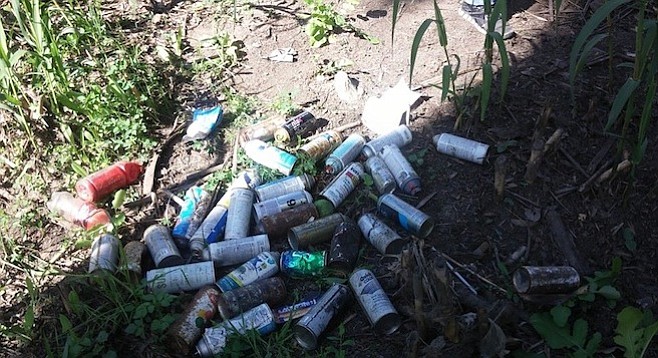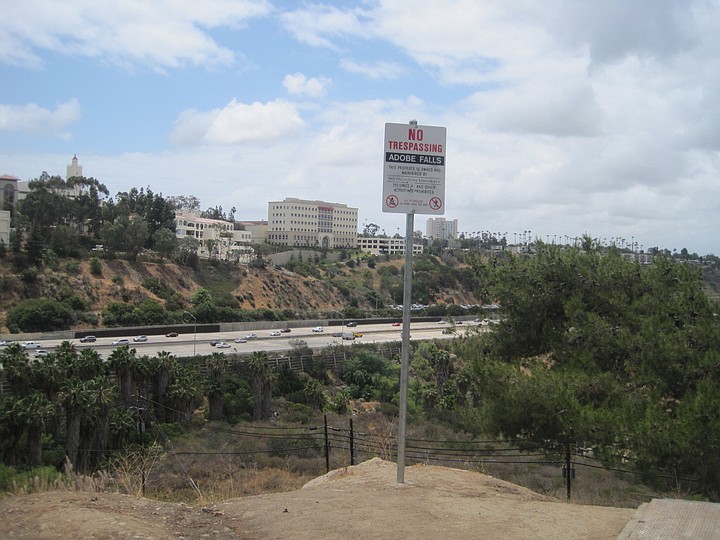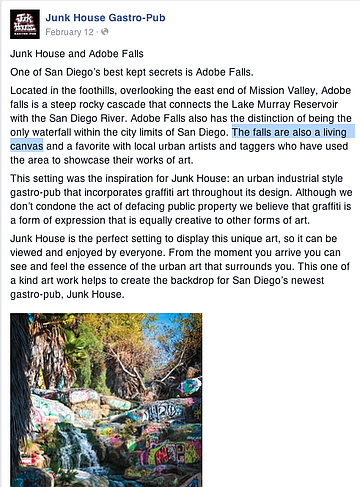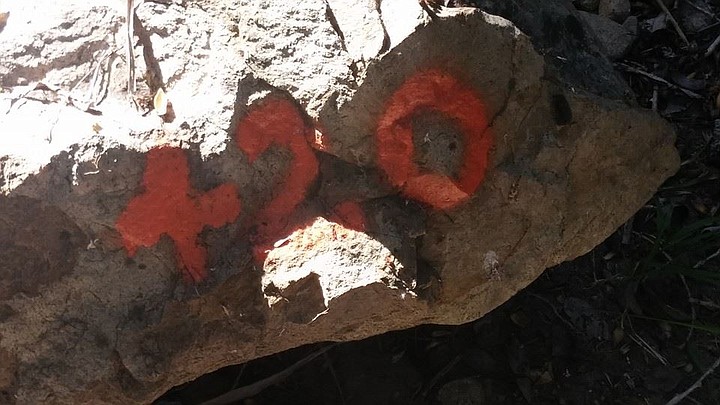 Facebook
Facebook
 X
X
 Instagram
Instagram
 TikTok
TikTok
 Youtube
Youtube

In response to concerns about Adobe Falls that Del Cerro residents raised last month, representatives from District 7 city councilman Scott Sherman's office will meet May 13 with San Diego State University staff, Liz Saidkhanian (Sherman’s director of outreach) said in a May 7 email. She and chief of staff Barrett Tetlow will attend what Saidkhanian called a "preliminary" meeting. "After this meeting, we will see what the next step is," she wrote.

Adobe Falls is across the I-8 freeway from SDSU. The university owns 42 acres of land north of westbound Interstate 8 and south of Adobe Falls Road in Del Cerro. While university land is closed to the public, the City of San Diego owns 4 acres north of SDSU's property. It is designated as open space.
Sherman spoke at the April 23 Del Cerro Action Council meeting and heard from residents who said that people continue to trespass and litter. A resident said he told some people the land was off limits; they responded, "The land belongs to SDSU, and we're students."

Graffiti in the area covers boulders and trees, and several residents criticized the "promotion" of the falls by the Junk House, a gastro-pub that opened March 17 on the Allied Gardens portion of Adobe Falls Road. Some people complained about the establishment’s graffiti art contest. (Panels from the competition are displayed outdoors and inside the restaurant.)
Furthermore, a man lamented to Sherman that he could no longer walk at Adobe Falls. After the councilman left, another man had a suggestion for Mark Peterson of the university police department and Dion Akers of university relations.
"Why not organize paid tours?" he asked.
Neither Sherman nor Akers commented about those remarks.
A woman who asked to be identified as "B" said signs stating the land was off limits were defaced or knocked down. Her backyard overlooks Adobe Falls, and we arranged to talk after the meeting.

"B" was among the Junk House critics. The bar’s website described the falls as "a living canvas where artists come to be creative and express themselves with beautiful murals and paintings."
The Junk House was designed to "fit into the neighborhood," general manager Richard Langlois said in a May 1 interview. The architect called for graffiti panels, and the Junk House contest awarded prize money to artists.
"A few residents who live at the end of the street shared their thoughts about the graffiti theme,” said Langlois. While residents thought the Junk House promoted graffiti, "we believe graffiti art is a form of art that should be displayed in the right context." Although the Junk House doesn't "condone the tagging and graffiti at the falls, it's been there for many years."
Asked about favorable reaction to the Junk House, Langlois said there are many compliments about the artwork, and some companies that do business with the Junk House bought panels. Garage doors open to "take advantage of natural light" and patrons "comment about how comfortable the light breezes are."

Langlois said he understood the residents' viewpoint. "I wouldn't like it if [someone] sprayed the back of my home." He added that some cities designate spaces for graffiti artists to display their work.
On May 7, "B" and I talked by phone while she emailed Adobe Falls pictures that included "420" sprayed on two boulders and empty spraypaint cans. "B" wasn't aware of Langlois's comment when she said, "You can't paint on the side of my house [and say you're an artist]. You're a vandal. I love art, even graffiti art when it's welcomed [like the murals] at Chicano Park." "B" ended the call when she saw four people head to the falls. "I have to call" and report them, she said.


In response to concerns about Adobe Falls that Del Cerro residents raised last month, representatives from District 7 city councilman Scott Sherman's office will meet May 13 with San Diego State University staff, Liz Saidkhanian (Sherman’s director of outreach) said in a May 7 email. She and chief of staff Barrett Tetlow will attend what Saidkhanian called a "preliminary" meeting. "After this meeting, we will see what the next step is," she wrote.

Adobe Falls is across the I-8 freeway from SDSU. The university owns 42 acres of land north of westbound Interstate 8 and south of Adobe Falls Road in Del Cerro. While university land is closed to the public, the City of San Diego owns 4 acres north of SDSU's property. It is designated as open space.
Sherman spoke at the April 23 Del Cerro Action Council meeting and heard from residents who said that people continue to trespass and litter. A resident said he told some people the land was off limits; they responded, "The land belongs to SDSU, and we're students."

Graffiti in the area covers boulders and trees, and several residents criticized the "promotion" of the falls by the Junk House, a gastro-pub that opened March 17 on the Allied Gardens portion of Adobe Falls Road. Some people complained about the establishment’s graffiti art contest. (Panels from the competition are displayed outdoors and inside the restaurant.)
Furthermore, a man lamented to Sherman that he could no longer walk at Adobe Falls. After the councilman left, another man had a suggestion for Mark Peterson of the university police department and Dion Akers of university relations.
"Why not organize paid tours?" he asked.
Neither Sherman nor Akers commented about those remarks.
A woman who asked to be identified as "B" said signs stating the land was off limits were defaced or knocked down. Her backyard overlooks Adobe Falls, and we arranged to talk after the meeting.

"B" was among the Junk House critics. The bar’s website described the falls as "a living canvas where artists come to be creative and express themselves with beautiful murals and paintings."
The Junk House was designed to "fit into the neighborhood," general manager Richard Langlois said in a May 1 interview. The architect called for graffiti panels, and the Junk House contest awarded prize money to artists.
"A few residents who live at the end of the street shared their thoughts about the graffiti theme,” said Langlois. While residents thought the Junk House promoted graffiti, "we believe graffiti art is a form of art that should be displayed in the right context." Although the Junk House doesn't "condone the tagging and graffiti at the falls, it's been there for many years."
Asked about favorable reaction to the Junk House, Langlois said there are many compliments about the artwork, and some companies that do business with the Junk House bought panels. Garage doors open to "take advantage of natural light" and patrons "comment about how comfortable the light breezes are."

Langlois said he understood the residents' viewpoint. "I wouldn't like it if [someone] sprayed the back of my home." He added that some cities designate spaces for graffiti artists to display their work.
On May 7, "B" and I talked by phone while she emailed Adobe Falls pictures that included "420" sprayed on two boulders and empty spraypaint cans. "B" wasn't aware of Langlois's comment when she said, "You can't paint on the side of my house [and say you're an artist]. You're a vandal. I love art, even graffiti art when it's welcomed [like the murals] at Chicano Park." "B" ended the call when she saw four people head to the falls. "I have to call" and report them, she said.
Comments